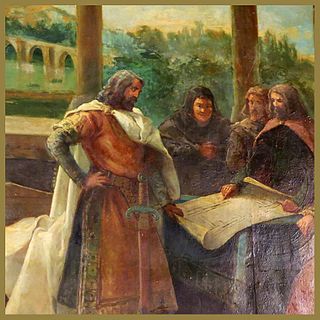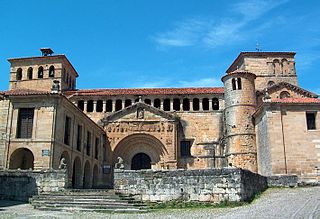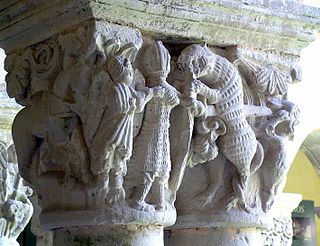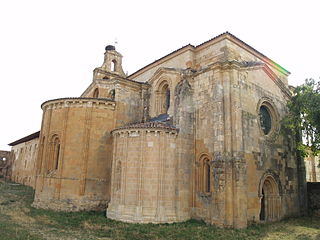Related Research Articles

Pedro Ansúrez was a Castilian nobleman, count of Liébana, Saldaña and Carrión in the closing decades of the eleventh century and the opening decades of the twelfth. He is considered the founder and first lord of Valladolid.
García Ordóñez, called de Nájera or de Cabra and Crispus or el Crespo de Grañón in the epic literature, was a Castilian magnate who ruled the Rioja, with his seat at Nájera, from 1080 until his death. He is famous in literature as the rival of Rodrigo Díaz de Vivar, the Cid, whose high position at court he took over after the Cid's exile in 1080. He was one of the most important military leaders and territorial governors under Alfonso VI, and was entrusted with military tutorship of the king's heir, Sancho Alfónsez, with whom he died on the field of battle at Uclés.
Pedro González de Lara was a Castilian magnate. He served Alfonso VI as a young man, and later became the lover of Alfonso's heiress, Queen Urraca. He may have joined the First Crusade in the following of Raymond IV of Toulouse, earning the nickname el Romero. At the height of his influence he was the most powerful person in the kingdom after the monarch. The preponderance of his power in Castile is attested in numerous documents between 1120 and 1127. He opposed the succession of Urraca's legitimate heir, Alfonso VII. This dispute ended with his premature death.

Fernando Díaz was a Spanish nobleman and military leader in the Kingdom of León, the most powerful Asturian magnate of the period. He held the highest rank in the kingdom, that of count, from at least 24 September 1089. He was the last Count of Asturias de Oviedo and was succeeded by a castellan, a novus homo, perhaps in an ecclesiastical–royal effort to curtail the power of the Asturian aristocracy.
Fernando González de Traba or Fernão Gonçalves was a Galician magnate and the head of the House of Traba in the Kingdom of León during the reign of Ferdinand II. He was the eldest son of Gonzalo Fernández de Traba and Elvira Rodríguez. He was the alférez of the realm from April 1159 until at least 31 July 1160. He was recognised as a count, the highest noble rank in the kingdom, by 13 January 1160 in Galicia, but the royal chancery did not so style him until 13 February 1161. He held the tenencias which his father had held: Aranga (1160–61), Traba (1160–61), Monterroso (1160–63), and Trastámara (1161–65), even holding all four simultaneously. He supported with donations the Cistercian monasteries of Sobrado (1162) and Monfero (1163). Fernando signed his last known charter on 26 December 1165. There exists a charter mistakenly dated 6 January 1165 by which his brother, Gómez González de Traba, made a donation to Jubia for the sake of his soul. He had no known wife or children.

Fernando Ponce de Cabrera, called el Menor, was an important nobleman of the Kingdom of León.
Fernando Ponce de Cabrera, called el Mayor, was an important nobleman of the Kingdom of León, the second son of three of Ponce de Cabrera, a Catalan baron who had emigrated to León, and his first wife, Sancha (?Núñez), who was deceased by 1142. He married Guiomar Rodríguez, daughter of Rodrigo Pérez de Traba. Between 13 February 1161 and August 1163 Fernando Ponce was the alférez or signifer (standard-bearer) of Ferdinand II, although it is possible that his younger brother of the same name, Fernando Ponce el Menor, is the one to whom the documents refer.

Gómez González, called de Lara or de Candespina, was a Castilian nobleman and military leader who had some claim to being Count of Castile. He was the eldest son and successor of Gonzalo Salvadórez and his wife Sancha, and thus kinsman of the Lara family. Like his father, he perished in battle.
Gómez González de Manzanedo was a Castilian magnate who governed Calahorra and defended the border with Navarre in the 1150s and 1160s. He spent three periods in the neighbouring Kingdom of León.
Gonzalo de Marañón was a Castilian magnate during the reigns of Alfonso VII (1126–57), Sancho III (1157–58), and Alfonso VIII (1158–1214). By January 1174 he had attained the rank of count, the highest in the kingdom. He was one of the earliest members of the Spanish nobility to adopt a toponymic surname as a family name. His interests lay in the far east of the kingdom, in areas once a part Navarre, and his toponymic indicates Navarrese origins.

Manrique Pérez de Lara was a magnate of the Kingdom of Castile and its regent from 1158 until his death. He was a leading figure of the House of Lara and one of the most important counsellors and generals of three successive Castilian monarchs: Alfonso VII (1126–57), Sancho III (1157–58) and Alfonso VIII (1158–1214).
Pedro Alfonso or Alfónsez was an Asturian magnate, dominating the region from 1139 until his death. He had vast landholdings in the Asturias, the region of León, and "kingdom" of Toledo, including in the cities of León and Toledo themselves, the most important cities of the realm. His commercial dealings were extensive, a sign of his economic power, and he loyally served Alfonso VII and his son Ferdinand II as a military commander and diplomat from 1128 until his death.

Rodrigo González de Lara was a Castilian nobleman of the House of Lara. Early in his career he ruled that half of Asturias allocated to Castile. He was faithful to the crown throughout the reign of Queen Urraca (1109–26), during which time he was married to the queen's half-sister and ruled a large part of the old County of Castile. He and his elder brother, Pedro González, led the opposition to Alfonso VII early in his reign (1126–57). He led a revolt in 1130 and was exiled in 1137. He was a leader in the Reconquista—about which the contemporary Chronica Adefonsi imperatoris has much to say—and also took part in the military activities of the Crusader states on two occasions. He travelled widely throughout Spain, but ended his days in Palestine.

Rodrigo Muñoz, son of Count Munio González and Mayor Muñoz, was a Castilian magnate in the kingdoms of León and Castile. His tenancies were mostly in Cantabria, in the northern Castilian lands bordering the Basque country.

Ramiro Fróilaz was a Leonese magnate, statesman, and military leader. He was a dominant figure in the kingdom during the reigns of Alfonso VII and Ferdinand II. He was primarily a territorial governor, but also a court figure, connected to royalty both by blood and by marriage. The military exploits of his sovereigns involved him against both the neighbouring kingdoms of Navarre and Portugal and in the Reconquista of the lands of al-Andalus.

Suero Vermúdez was an Asturian nobleman, territorial governor, and military leader. His career was marked by loyalty to the crown of León-Castile during the reigns of Alfonso VI, Urraca, and Alfonso VII. He never took part in any revolt, but fought in many wars against rebels, against rivals, and against the Moors.

García Garcés de Aza was a Castilian magnate "renowned for his wealth and dullness", yet "a prominent figure in the later Andalusian campaigns of the Emperor between 1150 and 1157". His toponymic appears in contemporary documents, referring to his ownership of the tenencia of Aza. His patronymic, "Garcés", reflects that he was son of count García Ordóñez, born to the latter's second wife, Eva, probably a Frenchwoman. After the death of García Ordóñez, she remarried to Pedro González de Lara, making García Garcés half-brother of Eva's children by Pedro and closely allied with the House of Lara.
FroilaMuñoz was a Leonese count. The sixty-seven surviving charters recording his property exchanges between 1007 and 1045 provide "compelling evidence of the active part that was being played by members of the aristocracy in the land markets of eleventh-century León" and that no "ecclesiastical monopoly on land investment and speculation existed." It is also partial evidence of a "spectacular increase in the mobility of land" in Christian Spain in the eleventh century "as both aristocratic families and ecclesiastical institutions sought to expand their domains at the expense of individual peasant proprietors". In the eleventh and twelfth centuries in Spain, serious crimes such as murder, rape, arson, robbery, and cattle rustling were generally punished by the local lord with the imposition of a calumnia, or compensatory fine. These were more often paid in land than in monies, and this contributed heavily to Froila's increase in landed wealth, as several of his charters demonstrate. A record of all these transactions is kept in the archives of the convent of Santa María de Otero de las Dueñas, to which its foundress, María Núñez, granted all her Leonese properties inherited from her ancestors, with their titles deeds, in 1240.

Ponce de Minerva was a nobleman, courtier, governor, and general serving, at different times, the kingdoms of León and Castile. Originally from Occitania, he came as a young man to León (1127), where he was raised probably in close connection to the royal family. His public career, first as a courtier and knight in the military retinue of Alfonso VII of León and Castile, began in 1140. By later historians he was implicated in the strife between Alfonso's successors, Sancho III of Castile and Ferdinand II of León, but he was generally loyal to the latter, although from 1168 to 1173 he was in voluntary exile serving Alfonso VIII of Castile.

The siege of Coria in July 1138 was the first and shorter of two attempts by Alfonso VII of León to take the city of Coria in Muslim Spain. Coria had previously been reconquered in 1079 by Alfonso VI, but was lost to the Almoravids not long after Alfonso's death in 1109. On the heels of a successful razzia (raid) deep into Islamic al-Andalus, Alfonso VII briefly invested the city before retiring. A second siege in 1142 was successful.
References
- Notes
- 1 2 3 Simon Barton, The Aristocracy in Twelfth-century León and Castile (Cambridge, 1997), 142–44.
- 1 2 3 4 Simon Barton, The Aristocracy in Twelfth-century León and Castile (Cambridge, 1997), 59.
- ↑ The date of the grant was 31 October 1212; the village was Castroverde; and the surviving charter reads: "for the many services which you have done me in the field of battle, carrying my standard as a brave man" (pro seruitio plurimum comendando quod michi in campestri prelio fecistis, cum uexillum meum sicut uir strenuus tenuistis, cum Almiralmomeninum regem Cartaginis deuici). Cited in Simon Barton, The Aristocracy in Twelfth-century León and Castile (Cambridge, 1997), 142 n217.
- ↑ Simon Barton, The Aristocracy in Twelfth-century León and Castile (Cambridge, 1997), 227.
- Further reading
- Fletcher, Richard A. (1989). The Quest for El Cid. New York: Alfred A. Knopf.